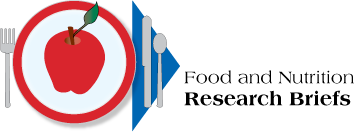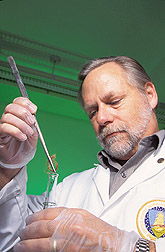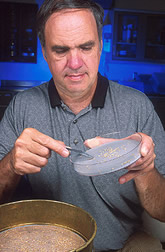This page has been archived and is being provided for reference purposes only. The page is no longer being updated, and therefore, links on the page may be invalid.
| May 2002 |
Peppers: Turning Down the HeatPopular peppers like TAM Sweet2 or Pace 103,105, and 106 lend jalapeño flavor to products like "chunky" salsa but don't add heat that could overwhelm some people's palates. The heat-free peppers are specially bred to be devoid of capsaicin--the compound responsible for adding the flame. Now, ARS scientists have provided much-needed details about how to best grow these new-generation peppers. In studies at the ARS South Central Agricultural Research Laboratory in Lane, Okla., researchers found that seedlings of most of the new pepper varieties could be successfully transplanted from greenhouse to field anytime from mid-April to mid-June and still yield a profitable crop. Too, the experiments showed that seedlings of some of the varieties can be planted closer together than is typical on commercial farms. Foodmakers can add just the right amount of piquancy to their products by using the new varieties in combination with precise quantities of capsaicin extracted from the earlier kinds of heat-imparting Capiscum peppers. For more information, contact Vincent M. Russo, (580) 889-7395, USDA-ARS South Central Agricultural Research Laboratory, Lane, OK Iron's Interference With Zinc ProbedMany pregnant women take prenatal iron supplements. A new study may determine if they can do that without disrupting the way their bodies use another vital nutrient--zinc.
ARS scientists at the Western Human Nutrition Research Center, Davis, Calif., along with colleagues from the University of California at Berkeley, are conducting the experiment. The findings will indicate whether taking iron supplements affects zinc uptake and use. For the study, the scientists have divided the volunteers into three groups of 12 participants each. Two groups are taking iron supplements, either in the morning with breakfast or at bedtime. The other group is not taking iron supplements. For further information, contact Janet C. King, (530) 752-5268, USDA-ARS Western Human Nutrition Research Center, Davis, CA. Online Nutrient Directory LaunchedNeed more calcium? Want to know what foods are rich in fiber? Now, a new online directory makes it fast and easy to find that information and more for some 1,147 familiar foods. Users can look up the amount of a specified nutrient on the electronic directory. It’s an abridged version of the Nutrient Database for Standard Reference, or SR14, which contains more than 6,000 items. ARS scientists at the Nutrient Data Laboratory developed SR14 using sophisticated analytical techniques to determine nutrient content of foods. This large database is the foundation for most public and private nutrient databases in the United States. The directory is located on the World Wide Web at http://www.nal.usda.gov/fnic/foodcomp. Once there, users can click on "Reports by Single Nutrients," located at the left about 10 lines from the top of the web page. The resulting page has a table listing nutrients such as protein, calcium, fiber, carbohydrate, cholesterol, or fats. For each nutrient that they specify, visitors can opt to have the directory "sorted alphabetically" by names of foods, or "sorted by nutrient content" from highest amounts, or best sources, to lowest amounts. For more information, contact David B. Haytowitz, (301) 504-0714, USDA-ARS Nutrient Data Laboratory, Beltsville, MD Tactic Might Yield Calcium-Enriched ProduceNew studies of plants’ mechanism for storing calcium might reveal ways to increase the amount of this essential mineral in potatoes, tomatoes, or other popular produce. That may happen in the future if experiments by plant scientists at the ARS Children’s Nutrition Research Center at Baylor College of Medicine continue to provide encouraging results. For tests, scientists used a tiny plant called Arabidopsis thaliana as a model. They found that a portion of an Arabidopsis protein known as CAX1 may be largely responsible for boosting the plant’s calcium content. CAX1 pulls calcium out of cellular fluids and stashes it in cell storage structures called vacuoles. The scientists envision the possibility of using CAX1 and other calcium transporters to move more calcium into vacuoles for storage. Ideally, that would--in turn --set off a physiological chain reaction, causing plants to pull more calcium out of the soil. In earlier studies, the scientists discovered that turning on the production of CAX1 in the cells of A. thaliana increased the calcium content of its leaves and roots by 30 to 100 percent. More recently, scientists removed the segment of interest from CAX1 and learned that the protein would no longer function. To further pinpoint the role of the segment, they moved it into another calcium-transporter protein that "looks" like CAX1. That made the lookalike protein newly function like CAX1. The team reported its findings in the Journal of Biological Chemistry (2001, vol. 276, no. 46, pp. 43152-43159). For more information, contact Kendal D. Hirschi, (713) 798-7011, USDA-ARS Children’s Nutrition Research Center at Baylor College of Medicine, Houston, TX Flour Yields Lower-Fat LoavesBreads that taste great yet are made with less fat than usual may result from experiments with waxy durum wheat. That’s according to scientists at the ARS Red River Valley Agricultural Research Center in Fargo, N.D. They are breeding and testing promising new waxy durum wheats in collaboration with researchers from North Dakota State University. The raised loaves that they made with 20 percent waxy durum flour in their experiments were soft and light. What's more, the test loaves stayed as fresh and soft after five days as those made with shortening. The researchers have been breeding waxy durum wheat and testing these flours for about five years. They report progress of their research in Cereal Chemistry (2002, vol. 79, pp. 178-182). The fat-replacing properties of waxy durum wheat flour likely derive from the atypical composition of its starch. Waxy durum wheat starch is made up almost entirely of a compound called amylopectin. In contrast, amylopectin makes up only about 76 percent of other wheat starch. For more information, contact Douglas Doehlert, (701) 239-1413, USDA-ARS Red River Valley Agricultural Research Center, Fargo, ND Herbs Can Spice Up Antioxidant ProtectionHerbs are known to be good sources of antioxidants, but their potency can vary depending on species and growing conditions. So an ARS researcher with the Fruit Laboratory in Beltsville, Md., and a visiting scientist from China evaluated 39 fresh culinary and medicinal herbs grown under the same environmental conditions at the same location--the U.S. National Arboretum in Washington, D.C. The antioxidant test that they employed is known as ORAC, short for Oxygen Radical Absorbance Capacity. It measures the ability of a sample to disarm unwanted oxidizing compounds, which our bodies naturally generate. The scientists, reporting in the Journal of Agricultural and Food Chemistry (2001, vol. 49, pp. 5165-5170) found that three different types of oregano scored highest in antioxidant activity. Mexican oregano (Poliomintha longiflora) is used in traditional Mexican and Southwest recipes. Its flavor is a bit stronger than Italian oregano (Origanum x majoricum). Also known as hard, sweet marjoram, Italian oregano is a versatile herb used to season meats, egg dishes, soups, and vegetables. Greek mountain oregano (O. vulgare ssp. hirtum), provides the piquant flavor associated with Italian pizza and classic Greek cuisine. Several other kitchen herbs, including rose geranium, sweet bay, dill, purple amaranth, and winter savory, also showed strong antioxidant activity. But, they were only one-third to one-half as potent as the oreganos. The medicinal herbs generally scored lower in antioxidant activity. For more information, contact Shiow Y. Wang, (301) 504-5776, USDA-ARS Fruit Laboratory, Beltsville, MD; Better Red Beans AheadNew, better-looking red beans for tomorrow are being developed from breeding lines produced by ARS scientists and their Michigan Agricultural Experiment Station co-researchers. The beans are plumper, more oval, and a more intense red. A key ingredient in chili products and mixes, red beans provide color and texture. They are also a good source of fiber, folic acid, and carbohydrates. In addition, the flavonoids that give the beans their bright-red color are antioxidants. The new red bean breeding lines offer better yields and improved resistance to some diseases. Too, they are more upright than other lines--a trait that makes them less susceptible to disease and weather-related damage that can occur in humid bean-growing regions of the Midwest and New York. The ARS and Experiment Station scientists are nationally known for the high-quality, top-performing beans that they have developed over the past 25 years. Details are in HortScience (1995, vol. 30, no. 7, pp. 1479-1482 and 2001, vol. 36, no. 7, pp. 1341-1343). For more information, contact George L. Hosfield, (517) 355-0110, USDA-ARS Sugarbeet and Bean Research Unit, East Lansing, MI Daughters May Mimic Parents’ Eating HabitsIf parents ate more fruits and vegetables, so did their daughters, researchers found in a study of 200 5-year-old girls and their parents. Scientists at the ARS Children’s Nutrition Research Center at Baylor College of Medicine and colleagues at Pennsylvania State University conducted this study. An article in the January 2002 issue of the Journal of the American Dietetic Association (vol. 102, pp. 58-64) has details. Conversely, scientists found that parents who pressured their daughters the most about eating fruits and vegetables were ironically those who consumed the least of these foods. Their daughters ate 1.6 fewer servings of fruits and vegetables a day than the daughters of parents who used less pressure. Parents can set a good example by eating plenty of fruits and vegetables and by not nagging. For more information, contact Jennifer O. Fisher, (713) 798-6766, USDA-ARS Children's Nutrition Research Center at Baylor College of Medicine, Houston, TX Can This Biopesticide Battle Aflatoxin?A new biopesticide developed by ARS scientists may help protect peanuts against aflatoxin, a natural contaminant. Currently, farmers lack direct means to control this fungal carcinogen. By law, peanuts with more than 15 parts per billion of aflatoxin can’t be used in foods like peanut butter. The main fungal culprits that produce aflatoxin, Aspergillus flavus and A. parasiticus, occur naturally in soils. Scientists at ARS’ National Peanut Research Laboratory in Dawson, Ga., have identified benign species of Aspergillus that compete with their aflatoxin-producing cousins for space and other resources that both need. Now, the scientists have perfected methods to grow, formulate, and apply the beneficial Aspergillus spores. Their approach, called biocompetitive exclusion, involves "seeding" these spores around the base of peanut plants. By colonizing soils in the peanut pod zone, the benign spores become a living shield that blocks the aflatoxin-producing species. Circle One Global, Inc., of Cuthbert, Ga., is testing commercial-scale methods of producing the biopesticide. For more information, contact Joe Dorner, (229) 995-7408, USDA-ARS National Peanut Research Laboratory, Dawson, GA Targeting Selenium’s SecretsNew data from a study of more than three dozen healthy men may help scientists learn more about selenium’s effects on the immune, cardiovascular, and reproductive systems. And, the investigation will reveal more details about this essential nutrient’s influence on body composition--the relative amount of fat-to-lean in our bodies.
Scientists at the ARS Western Human Nutrition Research Center, Davis, Calif., are collaborating in the study with colleagues from the University of California at Davis School of Medicine and Medical Center and the University of California at San Francisco. The study is a follow-up to earlier work described in Biological Trace Element Research (2001, vol. 81, no. 3, pp. 183-213). For more information, contact Chris Hawkes, (530) 752-4765, USDA-ARS Western Human Nutrition Research Center, Davis, CA Hydroprene--Tool For Fending Off Packaged-Food PestsPests that would like to munch on packaged foods such as breakfast cereals might be foiled by strategically placing an insect growth regulator, called hydroprene, where these pests might be hiding. That could include small, confined spaces in home pantries or retail stores.
Pointsource was originally marketed to fight cockroaches. As a result of the new ARS data, the red flour beetle and confused flour beetle have been added to the product label, so that Pointsource can now be used to fend off these pests as well. For more information, contact Franklin H. Arthur, (785) 776-2783, USDA-ARS Grain Marketing and Production Research Center, Manhattan, KS Vitamins Help Fight Colds and FluWhen cold and flu season comes around again, three vitamins might help bolster your body's defenses. Scientists at the Jean Mayer USDA Human Nutrition Research Center on Aging at Tufts University report this effect of vitamins E, B-6, and B-12 in Nutrition in Clinical Care (2001, vol. 4, no. 4, pp. 188-198). Their strongest evidence concerns vitamin E's effect on immunity. The scientists found that, when compared to a placebo, vitamin E supplements significantly improved volunteers' immune systems. B vitamins are already known to be essential for a healthy, well-functioning immune system. However, Tufts researchers indicate that many Americans are deficient in vitamins B-6 and B-12. Foods that provide B vitamins include fortified cereals, meat, fish, dairy products, starchy vegetables, and fruits--except citrus. Nuts, vegetable oils, and green leafy vegetables are good sources of vitamin E. For more information, contact Simin Nikbin Meydani, (617) 556-3129, Jean Mayer USDA Human Nutrition Research Center on Aging, Tufts University, Boston, MA |
|
The United States Department of Agriculture (USDA) prohibits discrimination in all its programs and activities on the basis of race, color, national origin, gender, religion, age, disability, political beliefs, sexual orientation, and marital or family status. (Not all prohibited bases apply to all programs.) Persons with disabilities who require alternative means for communication of program information (Braille, large print, audiotape, etc.) should contact USDA's TARGET Center at 202-720-2600 (voice and TDD). To file a complaint of discrimination, write USDA, Director, Office of Civil Rights, Room 326-W, Whitten Building, 14th and Independence Ave., SW, Washington, DC 20250-9410 or call 202-720-5964 (voice or TDD). USDA is an equal opportunity provider and employer. |


 The study is tracking pregnant volunteers, aged 20 to 40, from the beginning of their pregnancy through the first three months of breastfeeding. The work builds upon an earlier study which showed that pregnant women who took iron supplements prescribed by their physicians did not increase zinc absorption during breastfeeding (American Journal of Clinical Nutrition, vol. 66, pp. 80-88). That was in contrast to other volunteers who had not taken iron supplements.
The study is tracking pregnant volunteers, aged 20 to 40, from the beginning of their pregnancy through the first three months of breastfeeding. The work builds upon an earlier study which showed that pregnant women who took iron supplements prescribed by their physicians did not increase zinc absorption during breastfeeding (American Journal of Clinical Nutrition, vol. 66, pp. 80-88). That was in contrast to other volunteers who had not taken iron supplements. Half of the volunteers in the experiment are taking a daily capsule that provides five-and-one-half times the Recommended Dietary Allowance of selenium, in the form of high-selenium yeast, for the first year of the two-year study. The other volunteers take only a placebo. All volunteers undergo tests of their health at regular intervals. Study findings will help determine whether tomorrow’s breads, pastas, and other flour-based foods should be fortified with selenium to boost health.
Half of the volunteers in the experiment are taking a daily capsule that provides five-and-one-half times the Recommended Dietary Allowance of selenium, in the form of high-selenium yeast, for the first year of the two-year study. The other volunteers take only a placebo. All volunteers undergo tests of their health at regular intervals. Study findings will help determine whether tomorrow’s breads, pastas, and other flour-based foods should be fortified with selenium to boost health. ARS scientists at the Grain Marketing and Production Research Center in Manhattan, Kan., used hydroprene, sold as Pointsource, in experiments with red flour beetles and confused flour beetles. In lab studies, the scientists found that beetle larvae exposed to this compound--known as an insect growth regulator--often failed to molt to the adult stage. Of the insects that made it past this stunted-growth hurdle, most were deformed and soon died.
ARS scientists at the Grain Marketing and Production Research Center in Manhattan, Kan., used hydroprene, sold as Pointsource, in experiments with red flour beetles and confused flour beetles. In lab studies, the scientists found that beetle larvae exposed to this compound--known as an insect growth regulator--often failed to molt to the adult stage. Of the insects that made it past this stunted-growth hurdle, most were deformed and soon died.